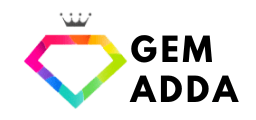Glass-filled Rubies

Nowadays new type of ruby is available in the market, called glass-filled ruby. Glass-filled ruby undergo a treatment process involving heating and injecting lead glass into surface-reaching fractures or cavities within the rubies. These fractures can occur naturally also during the mining and cutting process. This treatment improves color and fills cavities, creating a visually pleasing but low-quality gemstone. This process also involves treating lower-quality rubies with acid to remove mineralized inclusions.
Glass-filled rubies offer a more affordable option but are not on the same level as natural rubies in value, durability, and astrological effects. The glass-filling treatment makes the ruby more delicate and prone to breakage, which might not be suitable for everyday wear.
(How To Identify Glass- Filled Ruby)
1. Surface-Reaching Fractures: Glass-filled rubies show a visible network of cracks in a cobweb pattern, filled with lead glass. These cracks can be seen with the naked eye or under magnification. No such network of cracks is seen in non-filled rubies.
2. Color Patches: Glass-filled rubies have uneven red color patches and show an artificial hue. It can be seen easily in a strong light beam, indicating the glass-filling process. Natural rubies display a consistent color that spreads evenly across the gemstone.
3. Low Durability: Glass-filled rubies are fragile and can be easily damaged by heat, chemicals, or ultrasonic cleaning. Special care is advised when handling them. Natural rubies are durable and cannot be damaged by heat or chemicals.
4. Low Market Price: Glass-filled rubies are usually more budget-friendly than natural rubies due to their lower quality and filling of glass. Natural rubies always command a higher price.
5. Air bubbles: Tiny air bubbles can be spotted within the fractures of glass-filled rubies upon close inspection, revealing their treatment. These air bubbles are formed when glass is filled in the cracks of a ruby. At that time air gets trapped along with the glass.
6. Haziness: Glass-filled ruby has less transparency due to the glass filling and has some haziness. Due to this, it shows a waxy or greasy luster. On the other hand, without filling, rubies show a vitreous luster.
7. Changes in physical properties: After glass filling treatment, there are changes in the physical properties of a ruby, but to observe those, we need some gemological instruments. These changes mainly include;
A) Refractive index (R.I.)
The R.I. of glass-filled ruby becomes 1.540–1.550 due to glass filling, whereas the R.I. of natural unfilled ruby is 1.770–1.780. The bending ratio of light when it passes from one medium to another is called R.I.
B) Fluorescence
Non-filled rubies exhibit a red fluorescence in long-wave ultraviolet light, while lead-filled rubies show weak orange or non-fluorescence.
C) Spectroscopy
Spectroscopy identifies the chemical composition of gemstones. For this, an instrument spectrometer is used which analyzes the light passing through the stone and shows the result through color strips. This, reveals the presence of lead glass in a treated ruby.
